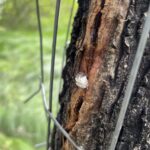Cottony Maple Scale
Leaf Feeding Insects & Mites
Cottony Maple Scale (Pulvinaria innumerabilis) is a common insect pest that affects many species of hardwood trees, including maple, sweetgum, willow, and elm. The adult female scale is about 1/8 inch long and produces a cottony, white, egg sac that can reach 1/2 inch in length. The eggs hatch into crawlers, which are tiny, mobile nymphs that move to a new feeding site on the tree. Over time, the nymphs mature into the adult female form, producing more eggs and covering themselves with a hard, brown scale that protects them from predators and the environment.
The feeding damage caused by Cottony Maple Scale is two-fold. First, the scale insects feed on sap from the tree, which can weaken the tree and reduce its overall health. Second, their feeding can also attract sooty mold fungi, which can further weaken the tree and reduce its ability to photosynthesize. The tree may also become more vulnerable to secondary pests and diseases, leading to further decline.
To manage Cottony Maple Scale, it is important to properly identify the insect and the stage of its life cycle. Treatment options include the use of horticultural oils, insecticides, and biological controls such as parasitic wasps. Proper care and maintenance of the tree, including proper pruning and mulching, can also help prevent infestations and promote overall health.
It is important to consult with a certified arborist or tree care professional for a proper diagnosis and treatment plan, as well as to ensure that the treatment does not harm the tree or the environment. With proper care, it is possible to manage Cottony Maple Scale and protect the health and beauty of trees in the landscape.



